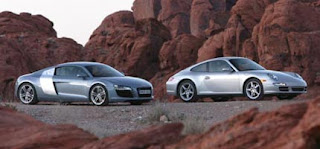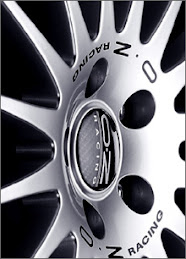
Head to Head: 2008 Audi R8 vs 2006 Porsche 911 Carrera 4
Photography by Brian Vance
Porsche's 911 has had the 24/7 supercar thing pretty much to itself for decades. Ferraris? Until recently, they've been way too fragile. Lamborghinis? Too highly strung. And both cost a fortune to maintain. No, if you wanted a high performance sports car you could use for the daily commute during the week, and a Sunday morning blast on your favorite back-road, it had to be the 911.
Audi's R8 changes all that. With its combination of performance, practicality, stunning looks, and Audi build quality, the R8 is the first serious rival for 911 in decades. So, should Porsche be worried by Audi's new supercar? We had to find out.
We rounded up a manual Carrera 4, figuring the entry-level all-wheel drive 911 would provide a pretty good baseline to work with. Our $82,865 tester (options included metallic paint, bi-xenon headlights, heated front seats and the Bose High End sound package and added $5765 to the base price) might have given away 95hp to the R8 but we wanted a car without PASM or other high-priced options so we could focus on the fundamentals.
Although a European spec car, our photographic R8 (also used for performance testing) was configured with what local Audi execs figure will be the default configuration for US buyers: R tronic transmission, dual mode magnetic ride shocks, and 19 inch wheels. To get the complete R8 picture, we also drove a regular six speed R8 with conventional shocks.
Before either car turns a wheel, the R8 lands a couple solid blows on the 911. Maybe its familiarity breeding contempt, but the aggressive, richly detailed R8 exterior, drawn by Frank Lamberty under the direction of Walter de'Silva, makes the 911 look dumpy and dowdy. Inside, the Porsche's austere, functional cockpit is simply overwhelmed by Audi interior designer Jens Sieber's sumptuous and sophisticated cabin.
The Porsche does boast a couple of occasional rear seats, while the Audi is a strict two-seater, but the benefit for R8 drivers is a lighter and more airy interior (and don't forget the room for two golf bags on the shelf behind the seats). The R8's interior is also the more ergonomic of the two, with better placement of pedals and switchgear (Audi's excellent MMI computer interface is standard) and minor controls that are easier to find and use.
The R8 also punches Porsche hard on the test track, nailing 60mph in just 4.1sec and the quarter mile in 12.6sec. With fewer horses, the Carrera 4 was not unexpectedly slower, taking half a second longer to get to 60, and six tenths longer to cover the quarter mile. Checking back through our records, the R8 is also faster than a 385hp Carrera 4S, but the 480hp 911 Turbo destroys it, nailing 60mph in 3.2sec, and the quarter in 11.4sec.
More impressive than the raw numbers, though, is the R8's demeanor in achieving them. Getting a fast time in a 911 involves side-stepping the clutch and gritting your teeth as the driveline thumps and bangs alarmingly; in the R tronic R8 you just switch off the traction control, squeeze the gas, and jump off the brake - the rear wheels spin briefly, then the car digs deep and lunges for the horizon, exhaust booming like a NASCAR stocker. Hardest part is making sure you fan the right hand paddle just as the tach needle hits 8000, right before the 8250rpm rev limiter snuffs the fire.
Both cars understeer on the race track. Lift off the gas in the R8, though, and the tail will come around in a smooth, clearly telegraphed transition instead of a white-knuckle snap. With the traction control disabled (which automatically lifts the intervention threshold of the stability control) the R8 will drift gently through the turn in a beautifully predictable slide. The Porsche will do the same; the difference is it's a lot harder to balance the car, and the margin for error is a whole lot smaller.
Audi engineers say they wanted the limits of the R8's chassis to be more approachable than those normally associated with the tail heavy Porsche 911. "It starts to rotate [from understeer to oversteer] earlier than a 911," admitted one, "but it's much more controllable." The Audi certainly feels better balanced and more confidence inspiring at the limit than the 911, and there's little evidence to suggest the R8's ultimate dynamic ability has been compromised much - Audi sources claim the R8 has lapped the legendary 14 mile Nurburgring Nordschliefe in 7min 55sec. That's only 13 seconds slower than the time posted by Porsche hot-shoe Walter Rohrl in the lighter, race-face 415hp 911 GT3 last June.
On the road the R8 is smoother, quieter and more refined than the Porsche. The R8's ride is excellent for mid-engine sports car on ultra-low profile tires and there's little difference in the ride quality between the standard and the sport settings with the optional magnetic ride shocks (they work is a similar fashion to those used by GM, using magnetically sensitive fluid to alter the damping rates) although the car turns in more crisply and rolls less in sport mode.
The R8 stops just as well as the Porsche well, too, thanks to the vented and cross-drilled disc brakes all round. The Audi's biggest dynamic weakness is its video-game steering, which just doesn't have the tactility of the 911's. The steering is accurate, but there's little feel or feedback through the helm; unlike the Porsche you have little sense that you're intimately connected to what's going on at the front of the car.
The Porsche has the better transmissions, too. We prefer the refinement of Porsche's Tiptronic auto to the surging R tronic if you want the car to do the thinking for you (though the paddleshift Audi is clearly faster than the regular stick version on the race track because you can left foot brake and change gears with the flick of a finger). And the manual 911's shifter moves with an oily precision no other car can match, least of all the notchy, deliberate unit in the manual R8.
The 911's wonderfully communicative steering and beautiful gearshift are reason enough to stay in love with it. But the R8's combination of easily accessible performance, confident handling, dazzling style, and lavish equipment make it a seductive proposition for drivers who want a genuine supercar they can enjoy every day of the week, any time of day.
1st Place
Audi R8
This car's a real game changer. Almost as fast and exotic looking as a Lamborghini, and as easy to live with as, well, an Audi.
2nd Place
Porsche 911 Carrera 4
No longer the obvious choice. Functional and durable, raw and tactile, but a little dowdy, and you have to be a hero to drive it really fast.
| | 2008 Audi R8 | 2006 Porsche 911 Carrera 4 |
| POWERTRAIN/CHASSIS | ||
| Drivetrain layout | Mid-engine, AWD | Rear engine, AWD |
| Engine type | 90-degree V-8, aluminum block/heads | Flat-6, aluminum block/heads |
| Valvetrain | DOHC, 4 valves/cyl | DOHC, 4 valves/cyl |
| Displacement | 254.1 cu in/4163cc | 219.4 cu in/3596cc |
| Compression ratio | 12.5:1 | 11.3:1 |
| Power (SAE NET) | 420 hp @ 7800 rpm | 325 hp @ 6800 rpm |
| Torque (SAE NET) | 317 lb-ft @ 4500 rpm | 273 lb-ft @ 4250 rpm |
| Redline | 8000 rpm | 7300 rpm |
| Weight to power | 8.2 lb/hp | 9.4 lb/hp |
| Transmission | 6-sp auto-clutch manual | 6-speed manual |
| Axle/final-drive ratios | 3.46:1/3.21:1 | 3.44:1/3.03:1 |
| Suspension, front; rear | Control arms, coil springs, adj shocks, anti-roll bar; control arms, coil springs, adj shocks, anti-roll bar | Struts, coil springs, anti-roll bar; multilink, coil springs, anti-roll bar |
| Steering ratio | 17.3:1 | 17.1:1-13.8:1 |
| Turns lock-to-lock | 3.2 | 2.7 |
| Brakes, f;r | 15.0-in vented, drilled disc; 14.0-in vented, drilled disc, ABS | 12.5-in vented, drilled disc;11.8-in vented, drilled disc, ABS |
| Tires, f;r | 235/35R19 91Y; 295/30R19 100Y Pirelli PZero | 235/40R18 91Y; 295/35R18 99Y Michelin Pilot Sport |
| DIMENSIONS | ||
| Wheelbase | 104.3 in | 92.5 in |
| Track, f/r | 64.3/62.7 in | 58.6/60.9 in |
| Length x width x height | 174.4 x 75.0 x 49.3 in | 175.6 x 72.9 x 51.6 in |
| Turning circle | 38.7 ft | N/A |
| Curb weight | 3550 lb (mfr) | 3345 lb |
| Weight dist., f/r | 44/56 % | 40/60 % |
| Seating capacity | 2 | 4 |
| Headroom, f/r | 37.7/ - in | 37.8/26.0 in |
| Legroom, f/r | 45.0/ - in (est) | 44.0/26.0 in |
| Shoulder room, f/r | 54.7/ - in | 51.5/ N/A in |
| Cargo volume | 3.5 cu ft | 3.4 cu ft |
| TEST DATA | ||
| Acceleration to mph | ||
| 0-30 | 1.4 sec | 1.6 sec |
| 0-40 | 2 | 2.3 |
| 0-50 | 3.2 | 3.5 |
| 0-60 | 4.1 | 4.6 |
| 0-70 | 5.5 | 6.2 |
| 0-80 | 6.8 | 7.8 |
| 0-90 | 8.2 | 9.4 |
| 0-100 | 10.3 | 11.8 |
| Passing, 45-65 mph | 2.1 | 2.2 |
| Quarter mile | 12.6 sec @ 111.5 mph | 13.2 sec @ 106.2 mph |
| Braking, 60-0 mph | 112 ft | 113 ft |
| Lateral acceleration | 0.94 g avg | 0.93 g avg |
| Top-gear revs @ 60 mph | 2650 rpm | 2400 rpm |
| CONSUMER INFO | ||
| Base price | $110,000 | $77,895 |
| Price as tested | $120,000 | $82,365 |
| Stability/traction control | Yes/yes | Yes/yes |
| Airbags | Dual front, front side/head | Dual front, front side, front curtain |
| Basic warranty | 4 yrs/50,000 miles | 4 yrs/50,000 miles |
| Powertrain warranty | 4 yrs/50,000 miles | 4 yrs/50,000 miles |
| Roadside assistance | 4 yrs/unlimited miles | 4 yrs/50,000 miles |
| Fuel capacity | 23.8 gal | 17.7 gal |
| EPA city/hwy econ | 15/21 mpg (est) | 17/25 mpg |
| Recommended fuel | Unleaded premium | Unleaded premium |





















No comments:
Post a Comment